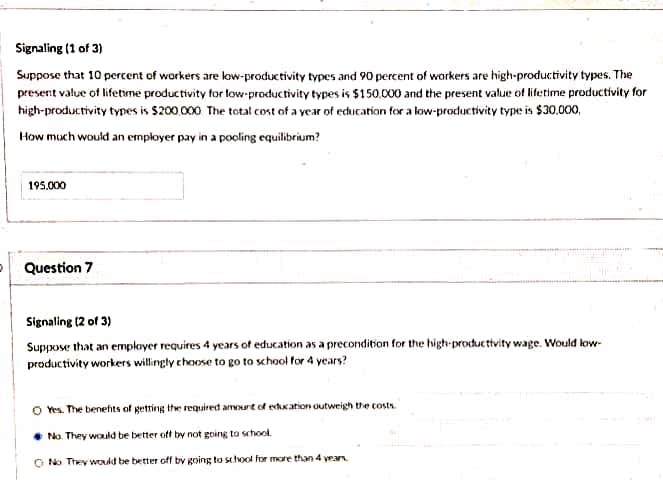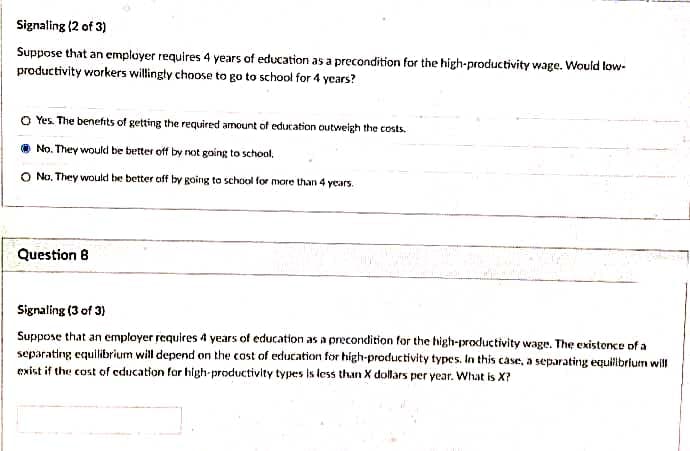Signaling (1 of 3) Suppose that 10 percent of workers are low-productivity types and 90 percent of workers are high-productivity types. The present value of lifetime productivity for low-productivity types is $150.000 and the present value of lifetime productivity for high-productivity types is $200.000 The total cost of a year of ecucation for a low-productivity type is $30,000, How much would an employer pay in a pooling equilibrium?
Signaling (1 of 3) Suppose that 10 percent of workers are low-productivity types and 90 percent of workers are high-productivity types. The present value of lifetime productivity for low-productivity types is $150.000 and the present value of lifetime productivity for high-productivity types is $200.000 The total cost of a year of ecucation for a low-productivity type is $30,000, How much would an employer pay in a pooling equilibrium?
Chapter17: Capital And Time
Section: Chapter Questions
Problem 17.11P
Related questions
Question
7

Transcribed Image Text:Signaling (1 of 3)
Suppose that 10 percent of workers are low-productivity types and 90 percent of workers are high-productivity types. The
present value of lifetime productivity for low-productivity types is $150.000 and the present value of lifetime productivity for
high-productivity types is $200,000 The total cost of a year of ecucation for a low-productivity type is $30,000,
How much would an employer pay in a pooling equilibrium?
195.000
P Question 7
Signaling (2 of 3)
Suppose that an employer requires 4 years of education as a precondition for the high-productivity wage. Would low-
productivity workers willingly choose to go to school for 4 years?
O Yes. The benefts of getting the required amourt of eduation outweigh the costs.
• No. They would be better oft by not going to school.
O No They would be better off by going to school for mare than 4 year

Transcribed Image Text:Signaling (2 of 3)
Suppose that an employer requires 4 years of education as a precondition for the high-productivity wage. Would low-
productivity workers willingty choose to go to school for 4 years?
O Yes. The benefits of getting the required amount of education outweigh the costs.
No. They would be better off by not going to school,
O No. They would be better off by going to school for more than 4 years.
Question 8
Signaling (3 of 3)
Suppose that an employer requires 4 years of education as a precondition for the high-productivity wage. The existence of a
separating equilibrium will depend on the cost of education for high-productivity types. In this case, a separating equilbrium will
exist if the cost of education for high-productivity types is less than X dollars per year. What is X?
Expert Solution
This question has been solved!
Explore an expertly crafted, step-by-step solution for a thorough understanding of key concepts.
This is a popular solution!
Trending now
This is a popular solution!
Step by step
Solved in 2 steps

Knowledge Booster
Learn more about
Need a deep-dive on the concept behind this application? Look no further. Learn more about this topic, economics and related others by exploring similar questions and additional content below.Recommended textbooks for you

